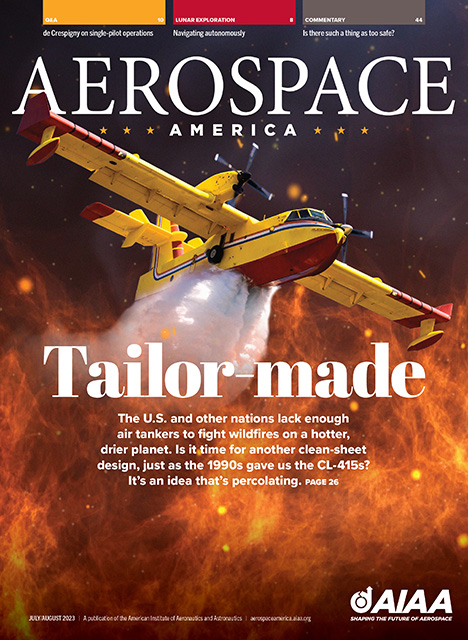Stay Up to Date
Submit your email address to receive the latest industry and Aerospace America news.
Proposing lower safety standards is unethical
Regarding the July/August commentary, “Safety versus innovation: It’s time for a rebalancing,” Jim Coder, AIAA associate fellow, writes that he’s “disappointed” by the publication of author Mislav Tolusic’s argument that aviation should “align our risk tolerance for air travel to that of automobile travel.” Coder notes that the 2022 road fatalities reported by the U.S. National Highway Traffic Safety Administration “correspond to approximately 117 passenger deaths per day. In terms of our industry, this statistic suggests we should be complacent if a widebody jetliner crashed every 2-3 days.”
Coder also believes that “Tolusic’s article stands in direct contrast to AIAA’s own code of ethics (and the fundamental ethics canons of every other engineering professional society), which states that members ‘Hold paramount the safety, health, and welfare of the public in the performance of their duties.”
AIAA member Steven O’Flarity writes that the cost examples cited in the article are “nearly meaningless.” Both the DC-6 and Boeing 707 “had a military derivation, lowering costs,” writes O’Flarity, a former director of systems engineering at Pratt and Whitney. “The 787 was the most innovation-packed airliner in decades with remarkable advances in materials and systems,” so comparing a DC-6 to a 787 is like comparing “a Model T to a Tesla.”
On the topic of novel aircraft designs, O’Flarity notes that “The biggest issues in the industry are emissions and airport noise. A blended-wing-body might aid both if challenges related to gate and ramp constraints, emergency egress, line maintenance access, airline and passenger acceptance, and entirely new manufacturing processes logistics, etc. are resolved.”
AIAA senior member Gary O’Neill notes that he’s “absolutely in favor of innovation and creating new and better ways to transport people and goods by air, and lowering the costs to do so,” but he suggests that safety standards are not the only hurdle. “Mundane things like wingspans that change the spacing between gates or taxiway clearances sometimes result in expensive and time-consuming alterations. Creating a shorter time cycle for such changes could result in fewer city pairs to fly the aircraft, which in turn affects the economics of purchasing new aircraft, no matter how cool the new technology is. Also, training for manufacturing personnel, pilots and cabin personnel, maintenance technicians and ground operations personnel needs to be factored into the transition cycles.”
The middle ground in the firefighting debate
On the question of whether clean-sheet designs are needed to fight wildfires, an idea explored in the July/August cover story, “Tomorrow’s firefighting fleet,” AIAA senior member Bill Fredericks writes that “this is NOT a binary decision, and the right answer is likely half way between” retrofitting existing aircraft and creating clean-sheet designs. “Take an existing design and apply external modifications to the design under a supplemental type certification process (or similar process depending on the relevant regulatory authority) to adapt the existing design to be better suited to the water bombing mission,” writes Fredericks, who is chief technology officer of Advanced Aircraft Co., a Virginia-based drone manufacturer. Specifically, he likes the idea of modifying the amphibious ShinMaywa US-2.
For his part, Robin Harrison, a retired U.S. Forest Service employee and AIAA senior member, notes that “just about any airframe can be adapted to do the firefighting job,” but an airtanker’s efficiency is measured by “the pattern and consistency of the retardant when it reaches the ground, which are dependent on the tank design.” While the Canadian Super Scoopers “can load from just about any body of water large enough, they are limited to dropping plain water or foam suppressant, not the long-term retardant that is most effective in building fire-line.”
Also, “I would have liked to have seen some mention of helicopters used in wildland firefighting. It is my opinion that in terms of response time and effectiveness, the heavy snorkel-equipped helicopter is the best initial attack vehicle.”
An idea for better lunar comms
After reading our July/August feature, “Live from the moon in HD,” AIAA senior member Stanley Clark has a possible solution for ensuring adequate bandwidth for future missions: Think of “Earth, Moon as a two node communication system with a trunk line connecting them,” writes Clark, a former systems engineer at United Space Alliance. High-bandwidth could be achieved “by setting up several lasers connecting Earth and the Moon in a laser trunk line and routing all Lunar space RF through the Lunar Node to be digitized, then sent to the Earth Node from the Lunar Node.” This would offload “a large chunk of communication requirements from the Deep Space Network and the NSN.”
Stay Up to Date
Submit your email address to receive the latest industry and Aerospace America news.





